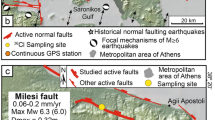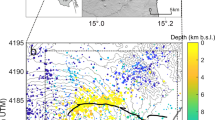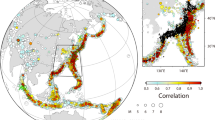Abstract
The seismic hazard associated with an individual fault can be assessed from the distributions of slip and recurrence times of earthquakes. However, seismic cycle models1 that aim to predict rupture lengths and fault displacements of successive earthquakes on one fault remain poorly validated. It is therefore unknown whether individual fault segments rupture independently, producing earthquakes with a diverse range of magnitudes and recurrence times, or slip by characteristic amounts, with characteristic magnitudes. Here we use high-resolution satellite data to document the horizontal offsets of stream channels and terraces created by strike-slip motion on the Fuyun fault, Xinjiang, China, during five historical earthquakes. We find that the Ms 7.9 11 August 1931 earthquake produced a surface rupture with a length of 160 km, dispersed over three different fault segments. The 290 measured stream channel and terrace offsets record an average slip of 6.3 m. We use the degree of preservation of geomorphological markers to assign relative ages to individual fault offsets and identify at least four distinct older earthquakes. We find that these older earthquakes also produced fault offsets with a similar distribution to the 1931 earthquake. As the slip distributions during five successive earthquakes were so similar, we conclude that ruptures on the Fuyun fault obey a characteristic slip model.
This is a preview of subscription content, access via your institution
Access options
Subscribe to this journal
Receive 12 print issues and online access
$259.00 per year
only $21.58 per issue
Buy this article
- Purchase on Springer Link
- Instant access to full article PDF
Prices may be subject to local taxes which are calculated during checkout



Similar content being viewed by others
References
Sieh, K. The repetition of large-earthquake ruptures. Proc. Natl Acad. Sci. USA 93, 3764–3771 (1996).
Shimazaki, K. & Nakata, T. Time-predictable recurrence model for large earthquakes. Geophys. Res. Lett. 7, 279–282 (1980).
Bakun, W. & McEvilly, T. V. Recurrence models and Parkfield, California. J. Geophys. Res. 89, 3051–3058 (1984).
Weldon, R., Fumal, T. & Biasi, G. P. Wrightwood and the earthquake cycle: What a long recurrence record tells us about how faults work. GSA Today 14, 4–10 (2004).
Sieh, K. Lateral offsets and revised dates of large earthquakes at Pallett Creek, California. J. Geophys. Res. 89, 7641–7670 (1984).
Daëron, M. et al. 12,000-year-long record of up to 14 paleo-earthquakes on the Yammoûneh fault (Levant fault system). Bull. Seismol. Soc. Am. 97, 749–771 (2007).
Klinger, Y. et al. Paleoseismic evidence of characteristic slip on the western segment of the North Anatolian Fault, Turkey. Bull. Seismol. Soc. Am. 93, 2317–2332 (2003).
Liu, J., Klinger, Y., Sieh, K. & Rubin, C. Six similar sequential ruptures of the San Andreas fault, Carrizo Plain, California. Geology 32, 649–652 (2004).
Zielke, O., Arrowsmith, J. R., Grant Ludwig, L. & Akçiz, S. O. Slip in the 1857 and earlier large earthquakes along the Carrizo Plain, San Andreas fault. Science 327, 1119–1122 (2010).
Wesnousky, S. Predicting the endpoints of earthquake ruptures. Nature 444, 358–360 (2006).
Klinger, Y. Relation between continental strike-slip earthquake segmentation and thickness of the crust. J. Geophys. Res. 115, B07306 (2010).
Lindvall, S., Rockwell, T. & Hudnut, K. Evidence for prehistoric earthquakes on the Superstition Hills fault from offset geomorphic features. Bull. Seismol. Soc. Am. 79, 342–361 (1989).
Kondo, H. et al. Slip distribution, fault geometry, and fault segmentation of the 1944 Bolu-Gerede earthquake rupture, North Anatolian Fault, Turkey. Bull. Seismol. Soc. Am. 95, 1234–1249 (2005).
Tapponnier, P. & Molnar, P. Active faulting and Cenozoic tectonics of the Tien Shan, Mongolia and Baykal regions. J. Geophys. Res. 84, 3425–3459 (1979).
Ding, G. (ed.) The Fuyun Earthquake Fault Zone in Xinjiang, China (Seismol. Press, 1985).
Kanamori, H. in Historical Seismograms and Earthquakes of the World (eds Lee, W. H. K., Meyers, H. & Shimazaki, K.) (Academic, 1988).
Jianbang, S., Xianyue, S. & Shumo, G. International Symposium on Continental Seismicity and Earthquake Prediction (Seismol. Press, 1984).
Awata, Y., Fu, B. & Zhang, Z. Re-investigation of the geometry and slip distribution of the 1931 Fuyun surface rupture, northwest China. AGU (Fall meeting Suppl.) abstr. #no. T41A-1930 (2008).
Lienkaemper, J. 1857 slip on the San Andreas fault southeast of Cholame, California. Bull. Seismol. Soc. Am. 91, 1659–1672 (2001).
Rockwell, T. et al. Lateral offsets on surveyed cultural features resulting from the 1999 Izmit and Duzce earthquakes, Turkey. Bull. Seismol. Soc. Am. 92, 79–94 (2002).
Klinger, Y., Michel, R. & King, G. C. P. Evidence for an earthquake barrier model from Mw similar to 7.8 Kokoxili (Tibet) earthquake slip-distribution. Earth Planet. Sci. Lett. 242, 354–364 (2006).
Lin, A. & Lin, S. Tree damage and surface displacement: The 1931 M 8.0 Fuyun earthquake. J. Geol. 106, 751–757 (1998).
Wells, D. L. & Coppersmith, K. J. New empirical relationships among magnitude, rupture length, rupture width, rupture area, and surface displacement. Bull. Seismol. Soc. Am. 84, 974–1002 (1994).
Lee, W. H. K., Kanamori, H., Jennings, P. C. & Kisslinger, C. International Handbook of Earthquake and Engineering Seismology (Academic, 2002).
Sieh, K. et al. Near-Field investigations of the Landers earthquake sequence, April to July 1992. Science 260, 171–176 (1993).
Haeussler, P. J. et al. Surface rupture and slip distribution of the Denali and Totschunda faults in the 3 November 2002 M 7.9 earthquake, Alaska. Bull. Seismol. Soc. Am. 94, S23–S52 (2004).
Wesnousky, S. G. Displacement and geometrical characteristics of earthquake surface ruptures: Issues and implications for seismic-hazard analysis and the process of earthquake rupture. Bull. Seismol. Soc. Am. 98, 1609–1632 (2008).
Calais, E. et al. GPS measurements of crustal deformation in the Baikal–Mongolia area (1994–2002): Implications for current kinematics of Asia. J. Geophys. Res. 108, 2501 (2003).
Shumo, G., Meixiang, B., Daozun, X. & Zhiyong, X. The recurrence intervals of major earthquakes at the active koktokay-Ertai fault. Earthq. Res. China 2, 67–80 (1986).
Baljinnyam, I. et al. Ruptures of Major Earthquakes and Active Deformation in Mongolia and its Surroundings, Geological Society of America Memoir 181 (The Geological Society of America, 1993).
Acknowledgements
Thanks are extended to the CNES, which gave us access to imagery in the framework of the Pleiade preparation program. We thank R. Arrowsmith and G. Biasi for constructive reviews. This is IPGP contribution 3157, and EOS contribution 20.
Author information
Authors and Affiliations
Contributions
M. E. carefully mapped offset markers along the fault. C.N. took care of much of the statistical modelling effort. They, and all other authors, equally participated in the completion of the work.
Corresponding author
Ethics declarations
Competing interests
The authors declare no competing financial interests.
Supplementary information
Supplementary Information
Supplementary Information (PDF 6474 kb)
Supplementary Information
Supplementary Information (XLSX 53 kb)
Supplementary Information
Supplementary Information (XLSX 38 kb)
Rights and permissions
About this article
Cite this article
Klinger, Y., Etchebes, M., Tapponnier, P. et al. Characteristic slip for five great earthquakes along the Fuyun fault in China. Nature Geosci 4, 389–392 (2011). https://doi.org/10.1038/ngeo1158
Received:
Accepted:
Published:
Issue Date:
DOI: https://doi.org/10.1038/ngeo1158
This article is cited by
-
Evaluating variability in coseismic slips of paleoearthquakes from an incomplete slip history: an example from displaced terrace flights across the Kamishiro fault, central Japan
Progress in Earth and Planetary Science (2021)
-
25,000 Years long seismic cycle in a slow deforming continental region of Mongolia
Scientific Reports (2021)
-
Spatiotemporal clustering of great earthquakes on a transform fault controlled by geometry
Nature Geoscience (2021)
-
Seismic hazard of multi-segment rupturing for the Anninghe–Zemuhe–Daliangshan fault region, southeastern Tibetan Plateau: constraints from geological and geodetic slip rates
Natural Hazards (2021)
-
Repeated giant earthquakes on the Wairarapa fault, New Zealand, revealed by Lidar-based paleoseismology
Scientific Reports (2020)



